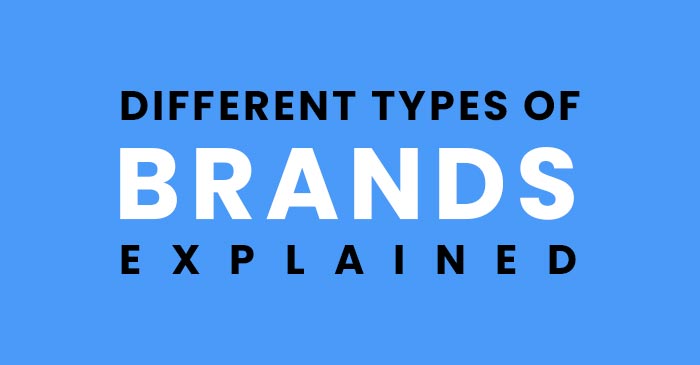
Brands are the essence of marketing. Understanding the different types of brands is among the most essential marketing and advertising strategies today. It helps a commodity, service, organization, or even an individual get broad recognition in their target market. In the contemporary market space, branding is not limited to goods and services alone.
In reality, every organization and business sector uses branding as a tool for achieving distinction, memorability, and identification. Branding is the process of assigning intangible characteristics to an offering to bestow it an identity and create a strong perception. Contrary to popular belief, branding is not limited to just a name and logo.
Similarly, a brand is an intangible concept that holds the promise of delivering a unique experience for users. All sorts of things can be turned into a brand – from products to services to companies to even geographic locations. Brands come in all shapes and sizes, each with something different to offer. It is up to us how we define them or categorize them into different types. Moreover, these categories are also why some types of brands opt to ‘rebrand’.
This blog covers the most common types of brands we can encounter in the market today. Understanding the different types of brands will help you determine what type of a brand your business or product is and how you can leverage it to its full potential.
Individual Brand
Personal brands are the powerful impressions that people create around themselves. They can be either positive or negative, resulting from personal capabilities and experiences or public opinions and views.
However, most experts argue that they should not be considered any type of brand at all, given they are often unrelated to a certain business strategy. Nonetheless, a brand personality is how we promote ourselves through personal interactions, media, social networks, and other channels to enhance our image and maybe increase our employment chances.
Product Brand
 Firms must develop their product brands to sell products, services, and commodities. These brands are comprised of feelings and concepts linked with a product. The connections and associations go beyond the product’s functional capabilities to include its public perception.
Firms must develop their product brands to sell products, services, and commodities. These brands are comprised of feelings and concepts linked with a product. The connections and associations go beyond the product’s functional capabilities to include its public perception.
Service Brand
The similarities between service brands and the aforementioned product brands are substantial. The primary distinction, however, is that service brands emphasize services rather than goods, making them more difficult to build.
Intangible brands are less palpable than physical items, which means that these different brands must often identify themselves with pleasant feelings and experiences to compete and succeed in the marketplace. At the same time, developing a service brand enables marketers to avoid skill-versus-skill judgments that are always difficult to demonstrate.
Additionally, there are certain innovative service-based types of brands that are known as membership brands, which have caused shifts in customer loyalty and technological expectations. In effect, they now market their services based on user interaction and value perception since these characteristics are highly desired by customers.
Corporate Brands
These trademarks are sometimes known as organizational brands since they are intimately associated with the organizations that support them. These types of brands eventually become the face of their organizations, inspiring trust and customer confidence in the company’s entire portfolio of products and services.
Generally speaking, corporate brands combine expertise, assets, values, and objectives essential to satisfy the demands of customers. In addition, they have a worldwide or local basis for comparison, performance data and civic activities, and a rich legacy that says volumes about the organization behind the global corporation. Coca-Cola is one of the most successful corporate brands in the world today, with a net worth of USD 87.6 billion.
Investor Brands
If an investor identity is strong, it will provide share price stability, economic value, trust, and recognition to the company. Mega brands like Pepsi, Nestle, and Apple command a solid market standing and higher share prices due to the stability and integrity provided by their investor brands.
The companies behind these types of brands are publicly traded and seen not just as assets but also as efficiency stocks. Therefore, for these companies to succeed, investors must combine their financial and operational expertise and work on their vision, mission, and value proposition. In addition, they should expand their reputation via CSR activities from the corporate platform.
Nonprofit Organization or NGO Brands
Although NGO branding is less rigorous or competitive than corporate branding, it is equally important to drive outreach efforts and communication and contribute to the organization’s funding activities.
Since numerous organizations are now fighting for a larger share of the charitable dollar, NGO branding is essential to cultivate trust and loyalty. These types of brands do not rely only on donations to further their social agendas; they need something more meaningful to stand for their values, goals, and messages. Additionally, NGO brands are attentive to value models.
Public Brands
 Public brands are also known as government brands. They are trademarks owned and associated with the state, representing government efforts, undertakings, and support programs provided to nationals and organizations within the country. Even though we cannot correlate these types of brands with consumer choice, they continue to exist. They are essential for strengthening public confidence in how the government conducts its affairs.
Public brands are also known as government brands. They are trademarks owned and associated with the state, representing government efforts, undertakings, and support programs provided to nationals and organizations within the country. Even though we cannot correlate these types of brands with consumer choice, they continue to exist. They are essential for strengthening public confidence in how the government conducts its affairs.
However, the majority of the population remains uncertain or unaware of their existence. Some individuals argue that public institutions should concentrate on building trustmarks rather than brand strategies to create public brands. In addition, some businesses are not governmental by nature, but they have grown so pervasive in our lifestyles that we nearly consider them as public services. Such types of brands include Google and Facebook, often known as embedded brands.
Activism Brands
These types of brands have a mission that is always associated with a social cause. However, they market and sell their mission so well that they achieve are able to a strong following amongst users and non-users alike. The key is to differentiate their brands in the eyes of the public by propagating a cause and embedding it with their branding. Body Shop is a fantastic example of brand activism since it is absolutely against animal cruelty.
National Brand
Nation brands, as opposed to local brands and locality-based tourist brands, refer to the identities and views of a country. They have a profound impact on the way a certain country is perceived by the rest of the world, especially for tourism, trade, and regional cooperation.
Ethical Brands
Different brands can develop ethical sub-brands and utilize them in two distinct ways. They may use them to illustrate how the brand operates and the techniques it employs to enhance the company image as a whole.
For instance, an ethical brand may prioritize sustainability and workers’ rights. At the same time, there are ethical brands that mirror positive societal values and environmental themes-type of branding. The presence of ethical brands is essential in our society because they convince people that the business is, first and foremost, responsible.
Global Brands
These types of brands, sometimes known as established brands, are globally renowned. Consequently, their economic strategy is often dependent on accessibility, familiarity, and consistency.
While it may be desirable for all businesses to become powerful global brands, to succeed in such types of branding is often extremely challenging. There are many complex decisions involved, which might even be conflicting. For example, the marketers must determine whether they need to standardize or customize the brand or if they should opt for global or local branding.
To remain relevant, companies involved in global branding must be able to balance these clashing demands. Consistency is, therefore, essential in establishing a worldwide brand. Today, while global branding is still practiced widely, most businesses are shifting to local branding to incorporate cultural preferences and customer expectations.
Challenger Brand
These so-called changemakers are altering how we perceive and use traditional marketing tools. Challenger brands compete with the top players in the industry and disrupt the sector in unconventional ways. As a result, they elevate customer aspirations to an entirely new, altering entire industries and creating new categories in the process. Examples include Tesla for their next-gen innovations and Airbnb as the first marketplace for people to rent out their own homes.
Premium Brand
Now, everyone is aware of what premium brands are. Typically, they are designer labels that are seen as status symbols, and most people are happy to pay a premium price for a premium brand.
Buyers purchase premium brands because they want to communicate a certain message about themselves or because they desire others to appreciate them. Premium branding promotes premium products via tales, connections, and quality. However, these brands are often susceptible to market movements and changes in customer tastes and fads.
The Bottom Line
A brand may be several different things at once. A product brand can be both a rival brand and a household name. This blog discusses different types of brands and types of branding to help you determine which category your business falls in.
At the same time, we wanted you to understand how different types of brands function and what you need to develop them organically. We must not forget that developing a strong brand will rely on its positioned settings and the classifications we use.
As there are several approaches to describing a single brand, marketers must ensure their brands produce value and align with the overarching brand theme. Furthermore, to create a strong type of brand, one must ensure it remains relevant and is, above all, distinguishable in any situation.
If you are looking for the ideal way to develop and express your brand uniqueness, look no further than Arturo Digital. We are a digital software company that turns ideas into memorable brands and help you get the competitive edge you need to succeed. Contact us for innovative branding solutions.